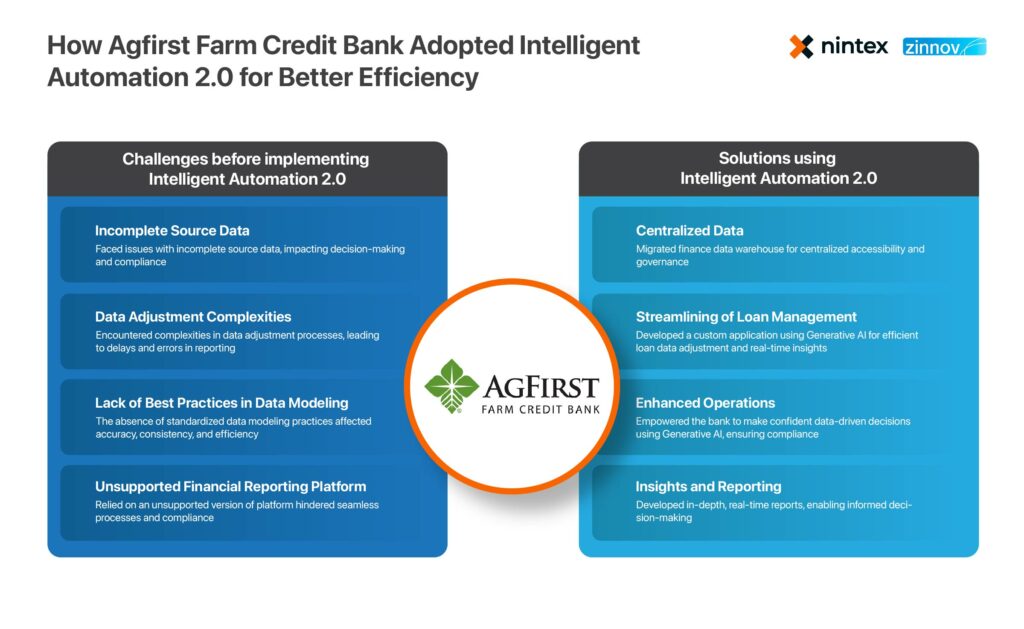|
|
There was a time when manual labor and paper-based systems were the heartbeat of every Enterprise. Fast-forward through the Social, Mobile, Analytics, and Cloud (SMAC) revolution, it was followed by the first wave of Intelligent Automation, one that metamorphosed businesses from the shackles of manual tedium to digital agility. Intelligent Automation began to streamline the corporate pulse where basic operations were automated.
With the rise of Intelligent Automation 2.0, a new era has dawned — the era of creative automation. Entire value chains are being automated without human intervention. Together, Robotic Process Automation, Intelligent Document Processing (IDP), Low Code/No Code, Intelligent Virtual Agent (IVA), and Intelligent Content Generation (ICG) play a vital role in creating Autonomous Workflows. This transformation is helping organizations move towards greater autonomy.
Let us try to understand how Autonomous Workflows differ from Automated Workflows:
Automated Workflows are systematic processes executed with technology, designed to reduce manual dependency, enhance efficiency, and minimize errors through predefined rules and conditions. Despite their automated nature, these workflows involve human oversight to monitor and ensure the system functions as intended. This human involvement is crucial in case of newer or more complex situations.
On the other hand, Autonomous Workflows involve the complete automation of the functional value chain (comprising multiple processes) without human involvement in any task execution or decision. They utilize advanced technologies with the confluence of Generative AI, ML, and Automation to achieve a high degree of autonomy. The entire system is self-learning, with automated maintenance and updates, eliminating the need for manual intervention to keep the workflow running smoothly. However, human oversight is necessary for governance purposes.
Enterprises are rapidly adopting Intelligent Automation 2.0 to enable Autonomous Workflows. Complementing traditional automation technologies (such as RPA, Low Code/No Code, IVA, and IDP), Intelligent Content Generation (ICG) paves the way for successful Autonomous Workflows. ICG is powered by Generative AI and enables the creation, summarization, and optimization of multi-format content.
Let us try to understand the automated and autonomous workflows in the context of the Procure-to-Pay function:
In the automated state of invoice processing, human supervision is required for certain new or critical tasks. The process involves collecting and storing digital invoices, with human intervention necessary for addressing delayed invoices. Additionally, the system performs invoice verification by matching invoices with purchase orders and goods receipts to ensure accuracy. Invoice data extraction and validation against predefined rules are conducted, with human intervention required to handle exceptions. Once the invoices are approved, the system ensures regulatory compliance by recording payments and saving invoices in accordance with regulatory standards.
In Autonomous Workflows, the entire procure-to-pay value chain gets automated. Procure-to-pay is a broader function that includes invoice processing among other processes. Let us dive into the specific tasks that are getting automated along with the role of technology in each step.
Take the example of AgFirst Farm Credit Bank. Due to challenges related to data availability, inconsistencies in data adjustment processes, and inaccurate financial insights, their decisions pertaining to loan management and overall operational efficiency were getting hampered. The bank recognized that overcoming these issues was crucial to maintaining data integrity and compliance and fostering sustainable growth. They then adopted Intelligent Automation 2.0 to solve these challenges.

By implementing Intelligent Automation 2.0 to create Autonomous Workflows for loan and database management, and financial reporting, AgFirst Farm Credit Bank achieved substantial improvements in their overall efficiency and experience levels. Using Autonomous Workflows, they were able to efficiently streamline loan management with real-time insights and data adjustments, thus reducing their loan processing cycle time from 48 hours to 20 minutes. They also centralized data assets with robust governance frameworks, allowing them to make data-driven decisions and navigate regulations successfully. With their autonomous capabilities, bank executives could also configure and customize their reports, feeding accurate results into the decision-making process.
There are various benefits organizations can reap from Autonomous Workflows that are powered by ICG (Intelligent Content Generation). These benefits include:
The rise of autonomous organizations signals a transformative shift in business operations amid a dynamic world. Continuous advances in technology hold boundless potential for heightened efficiency, innovation, and adaptability. Embracing Autonomous Workflows enables organizations to quickly navigate complex tasks, empowering employees for more strategic tasks and enhancing overall experiences. The growing sophistication of Generative AI promises diverse applications, providing customized solutions across industries. However, humans will still play a vital role in running these new-age enterprises that are powered by autonomous workflows. With autonomous workflows freeing them up for more strategic and value-added tasks, individuals are able to drive innovation, foster stronger human connections, and engage in high-touch interactions with customers and partners. Here’s how:
Here’s an example of how JP Morgan Chase & Co. is leveraging humans to ensure proper governance while they implement their Generative AI software.
Autonomous Workflows powered by Intelligent Automation 2.0 promise to be the game-changer for organizations across sectors. Leveraging advanced automation and AI technologies enables organizations to augment human capabilities, thereby enabling them to automate complex, creative, and analytical tasks as well. This will not only enable organizations to operate more efficiently but also help them leverage their human task force for more strategic tasks that require a human touch.